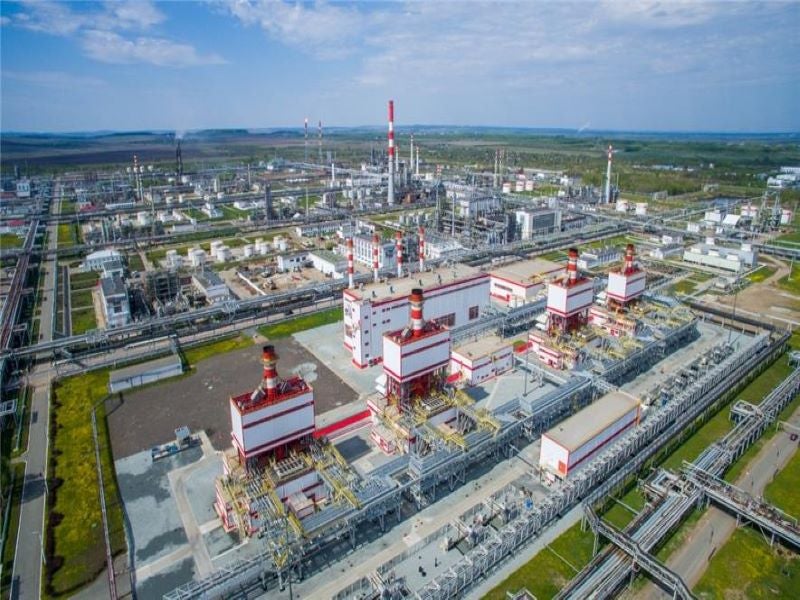The Perm refinery in Russia has been operational since November 1958 and became part of the Lukoil Group in 1991.
Owned and operated by Lukoil-Permnefteorgsintez, a wholly-owned subsidiary of Lukoil, the refinery has a crude oil processing capacity of 13.1 million tonnes a year (Mtpa).
The Lukoil Perm refinery had a Nelson Complexity Index (NCI) of 9.4 with a 69.2% light product yield and a 98.2% refining depth in 2020.
Lukoil launched the construction of a catalytic cracking complex at the refinery in August 2021. Scheduled to start operations in 2026, the new complex will handle 1.8Mtpa of feedstock to enhance the refinery’s high-octane motor gasoline output as well as enable the production of propylene feedstock for petrochemical plants.
Location and feedstock supply to the refinery
The refinery is located 5km away from Russia’s eastern-most city Perm, in the North Urals region, on the north bank of the Kama River.
The refinery mainly processes blended crudes from the northern Perm and the Western Siberia regions, supplied through the Surgut-Polotsk and the Kholmogory-Klin oil pipelines.
Production at Lukoil Perm refinery
The refinery produced 12.04 million tonnes (Mt) of petroleum products by processing 12.7Mt of crude oil in 2020. The products included 1.53Mt of petrol, 5.53Mt of diesel, 142,000 tonnes (t) of fuel oil, 598,000t of jet fuel, 953,000t of naphtha, 1.03Mt of vacuum gas oil, 775,000t of coke, 629,000t of bunker fuel, and 78,000t of petrochemicals.
The refined products are transported through the Perm-Andreevka-Ufa oil product pipeline as well as by rail, road, and river. Approximately 40% of the refinery’s output is exported to other countries.
Processing facilities at Perm oil refinery
The various processing modules in the Perm refinery include a 259,500 barrels per day (bpd) crude distillation unit, a 116,300bpd vacuum distillation facility, a 56,000bpd coking unit, a 9,300bpd catalytic cracking unit, a 36,900bpd catalytic reforming unit, and a 65,200bpd catalytic hydrocracking unit.
The refinery also houses a 131,000bpd catalytic hydrotreating unit, a 2,200bpd aromatics unit, and a 13,000bpd isomerisation unit, apart from a diesel hydrotreatment unit.
The other facilities in the refinery include a 9,400bpd lubricants production unit, a 15,100bpd bitumen production unit, a 56.5 million cubic feet a day (Mcfd) hydrogen production unit, and a 316t a day (tpd) sulphur production unit.
The new catalytic cracking complex being built in the refinery will have a catalytic cracking unit, along with a facility to produce high-octane gasoline components.
Gas processing complex at Perm refinery
The refinery’s gas processing complex has an annual gas processing capacity of 1,460 million cubic metres (Mcm) and a natural gas liquids (NGL) processing capacity of 1.7Mtpa. Commissioned in 1969, the gas processing facilities have been part of the Lukoil Group since 1998.
It receives associated gas from Lukoil-operated fields in the northern part of the Volga Urals Basin, as well as the broad fraction of light hydrocarbons (BFLH) from the Lokosovsky gas processing plant.
Recently completed projects at the refinery
A 200MW combined heat and power (CHP) plant with 435 Giga calories per hour (Gcal/h) heating capacity was commissioned at the Perm refinery in 2015, while the reconstruction of the diesel fuel hydro dearomatisation (HDA) block of the refinery’s hydrocracker unit was completed in October 2016.
An oil residue processing complex involving a new delayed coking unit was commissioned in November 2015. It led to a more than two-fold increase in the total coke production capacity of the refinery while allowing flexibility to produce different coke grades based on the market demand.
A rail trestle for up to 1Mtpa of fuel oil discharge from the refinery started operations in 2017. It also enabled the transport of heavy petroleum feedstock from the Nizhny Novgorod refinery to the Perm refinery.
The Perm refinery commenced production from the 2,400tpa petroleum bitumen facility in May 2018.





